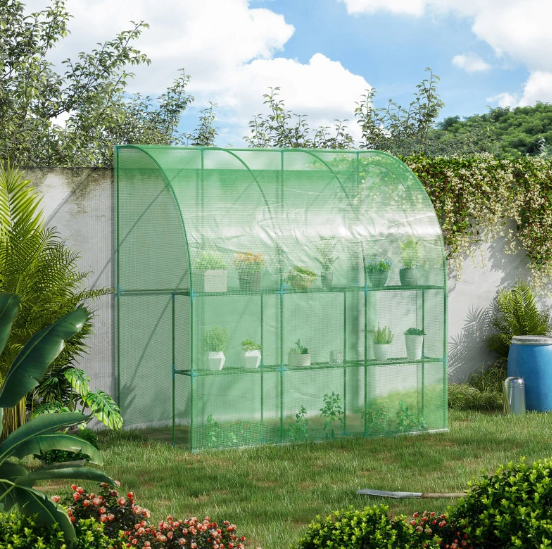Lean-to greenhouses offer a cost-effective and space-saving solution for avid gardeners.
We are a leading UK supplier of lean-to greenhouses.
Unlike traditional standalone greenhouses, lean-to structures are built against an existing wall, reducing material costs and making the most of limited space.
This blog will guide you through the process of planning, building, and customising your lean-to greenhouse, ensuring you can enjoy year-round gardening without breaking the bank.
Getting Started with Your Lean-To Greenhouse
Before you begin building your lean-to greenhouse, it's essential to assess the available space and plan accordingly.
Consider factors such as accessibility, sunlight exposure, and proximity to utilities. Choosing and adapting the right plans is crucial for ensuring your greenhouse fits seamlessly into your space and meets your gardening needs.
Assessing Available Space and Accessibility
- Measure the area where you plan to build your greenhouse.
- Ensure the location receives adequate sunlight, ideally 6-8 hours of direct sunlight per day.
- Check the proximity to water sources and electrical outlets for heating and ventilation systems.
Choosing and Adapting Greenhouse Plans
- Look for plans that match your space and material availability.
- Consider free online resources or purchase detailed plans from reputable sources.
- Be prepared to adapt plans to fit your specific needs and constraints.
🔑 Key Takeaway: Proper planning and assessment of your space and resources are critical to the success of your lean-to greenhouse project.
Selecting Materials for Your Greenhouse
Choosing the right materials for your greenhouse can significantly impact its durability, efficiency, and overall cost.
From the frame to the roofing, each component plays a vital role in the greenhouse's performance.
Benefits of Using Wood vs. Aluminium Frames
Wood Frames:
- Readily available and easy to work with.
- Offer good insulation properties.
- Can be stained or painted to match existing structures.
Aluminium Frames:
- Lightweight and durable.
- Resistant to rust and corrosion.
- Requires less maintenance over time.
Choosing the Right Roofing Material
Polycarbonate Panels (available through us):
- UV-protected and available in various sun-blocking strengths.
- Durable and lightweight.
- Allows for customizable light transmission levels.
Step-by-Step Building Guide
Building a lean-to greenhouse involves several key steps, from framing the structure to installing the roof. Follow this detailed guide to ensure a successful build.
Framing and Installing Windows
- First, remove any existing exterior coverings on the patio wall.
- Strip paint from old windows, caulk, prime, and paint them.
- Frame the windows in place, ensuring a snug fit for temperature control.
Building the Greenhouse Base
- Construct the base using 2x4s and plywood.
- Ensure the base is level and square, compensating for any uneven surfaces.
- Box in the base for potential future storage.
Framing the Roof
- Adapt truss angles to fit your specific greenhouse dimensions.
- Stain the wood as you go to protect it from the elements.
- Use mock-ups to determine the correct angles for roof trusses.
Installing the Roof Panels
- Use foam ridgeways to secure the panels along support beams.
- Install roofing screws with rubber washers on alternate ridges.
- Ensure a tight seal to prevent leaks and maximize insulation.
🔑 Key Takeaway: Following a detailed, step-by-step guide ensures a smooth building process and helps avoid common pitfalls during construction.
Interior Setup and Customisation
Maximising the interior space of your lean-to greenhouse is essential for creating an efficient and productive growing environment. Customize the interior to suit your specific gardening needs.
Utilising The Interior Space Efficiently
- Install temporary wire shelves for seed starting and tray placement.
- Use hanging planters to make the most of vertical space.
Add Temporary Shelves for Seed Starting
- Place wire shelves at waist height for easy access.
- Adjust shelf placement based on the height of your plants and trays.
Creating Storage Space
- Utilise the boxed-in base for storing pots, trays, and gardening tools.
- Consider adding roll-out bins for easy access to supplies.
Managing Greenhouse Conditions
Proper temperature and humidity management are crucial for maintaining a healthy greenhouse environment.
Understanding how to regulate these conditions will ensure your plants thrive year-round.
Know The Temperature Fluctuations
- Recognise that greenhouses heat up during the day and cool down at night.
- Plan for supplemental heating in cold climates to protect tender plants.
Installing Supplemental Heating
- Use electric heaters or heat lamps to maintain optimal temperatures.
- Consider installing a thermostat to automate temperature control.
Incorporating Ventilation and Air Circulation
- Install roof vents or windows that can be opened for airflow.
- Use fans or automatic vent openers to ensure consistent air circulation.
🔑 Key Takeaway: Effective temperature and humidity management are essential for creating a stable and productive greenhouse environment.
Adapting Plans to Fit Your Specific Needs
Adapting existing greenhouse plans to suit your unique situation can make the project more manageable and tailored to your needs.
Consider the specific requirements of your space and the types of plants you wish to grow.
Modifying Plans for Unique Situations
- Adjust dimensions to fit available space and desired plant height.
- Rework door and window placements for optimal accessibility.
Ensuring Accessibility and Plant Height Considerations
- Build at table height for easy access to plants.
- Plan for sufficient vertical space for the types of plants you intend to grow.
🔑 Key Takeaway: Customizing greenhouse plans to fit your specific needs ensures a more functional and personalized growing space.
Final Key Tips for Successful Greenhouse Building
Building a greenhouse can come with unexpected challenges. These tips will help you navigate common issues and ensure a successful project.
Check Wood Measurements
- Verify the actual dimensions of each piece of wood before cutting.
- Adjust plans as needed to accommodate any discrepancies.
Deal with Uneven Foundations
- Use shims or adjustable supports to level the base on uneven surfaces.
- Ensure the structure is stable and secure.
handle Any Unexpected Challenges Calmly
- Be prepared to adapt and problem-solve as you build.
- Keep a positive attitude and learn from any mistakes.
🔑 Key Takeaway: Flexibility and attention to detail are key to overcoming challenges and achieving a successful greenhouse build.
Optional Extras and Enhancements
Enhancing your lean-to greenhouse with optional extras can improve functionality and convenience.
Consider these additions to make your greenhouse even more effective.
Automatic Window Openers and Roof Vents
- Install automatic openers to maintain consistent temperature and humidity levels.
- Add roof vents to improve air circulation and prevent overheating.
Adding a Shade Cloth for Summer
- Use a shade cloth to reduce heat and light intensity during the summer months.
- Choose a cloth with the appropriate shading percentage for your plants.
Final Thoughts and Encouragement
Building a lean-to greenhouse is a rewarding project that can provide fresh produce and a green oasis year-round.
Whether you follow detailed plans or adapt your own, the process is a valuable learning experience that results in a functional and beautiful addition to your home.
Good luck!

